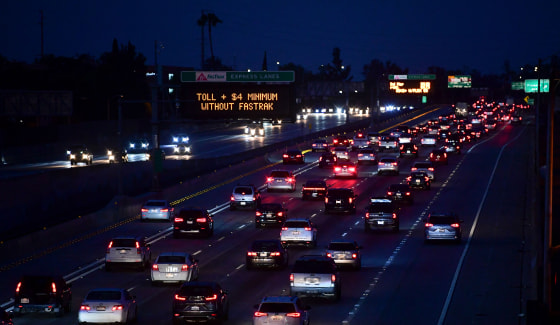The Biden administration plans to slowly ramp up pollution and mileage requirements for cars and trucks over the next five years as it works to cut the biggest U.S. source of greenhouse gas emissions and hasten the shift toward electric vehicles, people with knowledge of the plan tell NBC News.
New tailpipe requirements expected to be announced next week by the Environmental Protection Agency and the Transportation Department will put the U.S. back on track toward faster efficiency improvements that were scaled back under former President Donald Trump.
Still, the relatively modest pace envisioned over the next several years is likely to disappoint climate activists who say too much time was already lost during the Trump years.
“Now is the time for strong rules, not half measures,” the nonprofit Center for Biological Diversity wrote in a full-page ad Wednesday in The New York Times. “President Biden can set strong clean car standards that protect the climate – or he can hit reverse.”
The EPA and the Transportation Department had no comment.
Under the forthcoming rules, described to NBC News by a government official and an industry official briefed on the plan, the Biden administration will allow the weaker Trump-era standards to stay in place through Model Year 2022, a reflection of the fact that it’s all but too late to change the rules for vehicles already in or near production. Trump’s standards require an annual increase in fuel efficiency of 1.5 percent.
Starting in Model Year 2023, which includes vehicles that will start to be sold next year, auto-makers will be required to meet the standards enshrined in a 2019 deal between major automakers and the State of California, which set its own standards more stringent than the federal government’s. Those standards require a roughly 3.7 percent increase in vehicle standards per year.
Then in Model Year 2025, people briefed on the proposal said, auto companies will be expected to implement the more stringent standards that former President Barack Obama put in place before Trump undid them.
Obama’s rules, put in place in 2012, required a 5 percent annual increase in fuel economy standards. If the Obama rules had been left intact, they were predicted to raise mileage standards to an average of 54.5 miles per gallon by Model Year 2025, although many vehicles would likely have fallen short of that under real-world driving conditions.
By Model Year 2026, the new Biden rules will be even more ambitious than the Obama standards, requiring faster efficiency improvements, although it’s not yet clear by how much. Details of the plan were first reported by The Associated Press.
Although the Biden administration does not plan to announce specific numbers for vehicle standards after 2026, the announcement is expected to set broader goals of moving toward a “long-term multipollutant standard” and substantially increasing the percentage of vehicles sold that are zero-emissions by 2030, people briefed on the plan said.
Transportation, such as emissions from cars and trucks, makes up about 29 percent of U.S. emissions of heat-trapping gases blamed for global warming, according to EPA data. It’s the largest chunk of U.S. emissions, even exceeding those from generating electricity nationwide.
In the run-up to the new emissions standards for gas-burning cars and trucks, the Biden administration has also signaled to the auto industry that it wants 40 percent of vehicles sold by 2030 to be electric, people familiar with the discussions said.
Already, major automakers have taken significant strides in that direction. In May, Biden traveled to Michigan to test-drive the new Ford F-150 Lightning, an electric version of America’s most popular pickup truck. General Motors this year announced plans to phase out internal combustion engines and go all-electric by 2035.
Yet GM and other automakers have also been lobbying the Biden administration to be more lenient in setting efficiency standards for gas-guzzling vehicles in the meantime. Their argument has centered on the notion that the more they must spend in the short term to increase efficiency, the less they can spend on developing new electric models and driving down the cost, ultimately slowing the country’s shift toward electric vehicles.
The new nationwide standards come as the Biden administration is moving toward allowing California to once again set its own vehicle rules that are stricter than the federal government’s. California had previously been granted permission to go its own way until Trump’s administration withdrew the state’s waiver in 2019.
In a letter this week to EPA Administrator Michael Regan organized in part by Senate Environment and Public Works Committee Chairman Tom Carper, 26 Democratic senators urged the EPA to reinstate California’s waiver and clear the way for the state to impose stricter rules. Another 113 House lawmakers signed a similar letter to Regan.
“These regulatory programs lead to life-saving air quality improvements, which is especially critical for people of color and low-income communities, who experience disproportionate harm from motor vehicle pollution,” the lawmakers wrote. “The mounting threats to health and welfare posed by climate change makes the authority of the states to lead more important than ever.”

